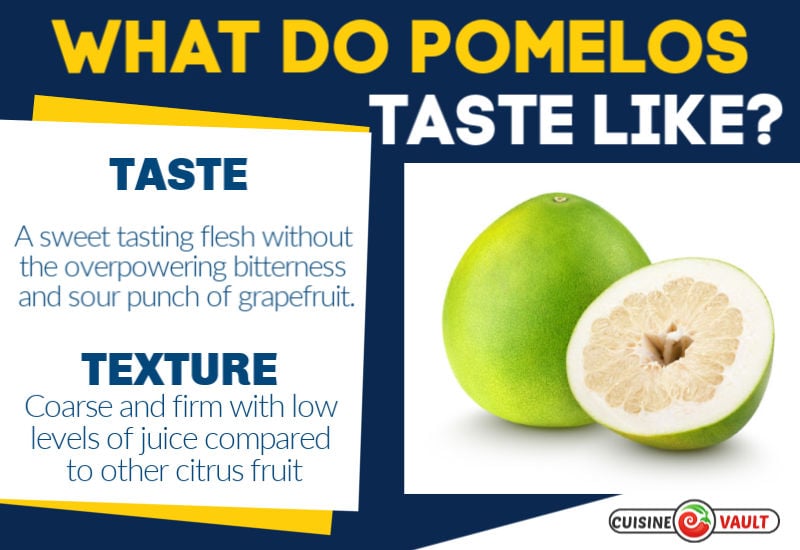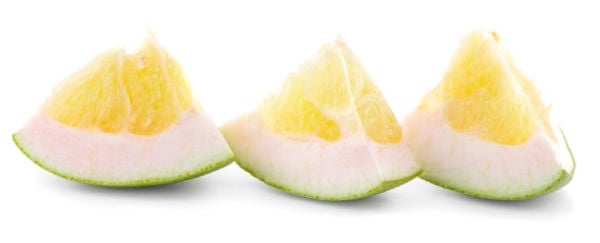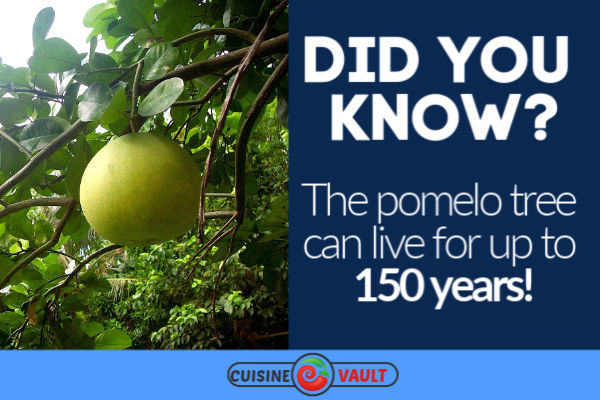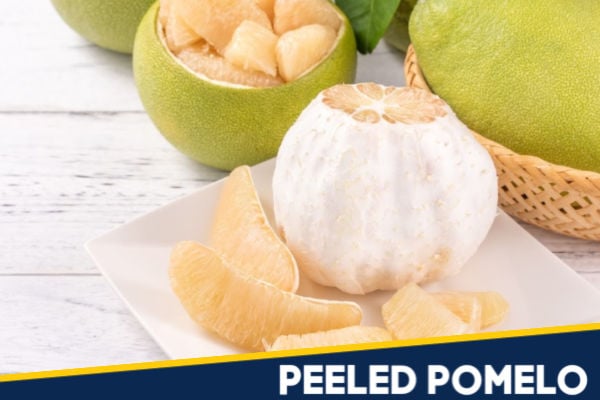A pomelo is a tropical citrus fruit that flourishes in the warmer climates of Southeast Asia, China, the Caribbean, and even the United States. This large yellow (or light green) fruit is an ancestor of the grapefruit, which should come as no surprise as they look very similar.
In the grocery store, they are hard to miss due to their size. If you’re considering buying one, then you may we wondering what does a pomelo taste like? Is it similar to grapefruit, or does it have a more exotic twist? We’ll answer that question in this article, and look at how to prepare and eat them.
Describing the pomelo flavor
A pomelo fruit tastes a lot like grapefruit, without the intensity of flavor that many people struggle with. They offer a pleasantly sweet-tasting flesh, but there is no overpowering bitterness and sour punch.
The pulp’s texture is coarse and firm with low levels of juice compared to other citrus fruit. You’ll also notice that the white pith, between each segment of fruit, is tough and bitter - definitely unpleasant to eat. With any citrus fruit, it’s best to remove it, but this is especially the case with pomelos.
Prefer to sit back and listen?
Many pomelo varieties are blessed with very few or no pips, so there is no need to fish through each segment, trying to scoop them out.

Pomelo Vs. Grapefruit
Although these two types of fruit look and taste similar, they also have significant differences that need pointing out. Here’s our quick comparison:
| Pomelo | Grapefruit |
|---|---|
| Thicker skin | Thinner skin |
| Easier to peel | Harder to peel |
| Often few or no pips | Often multiple pips |
| Mild flavor | Intense flavor |
| More sweetness | Less sweetness |
| Less juice | More juice |
| Bigger | Smaller |
| Lower bitter and sour | Higher bitter and sour |
| Firmer flesh | Softer flesh |
| Bitter aroma | Bitter aroma |
Comparing the flavor of pomelo varieties
Tahitian
The Tahitian pummelo is considered the best on the market for delicious flavor and texture. They are extremely sweet, although prone to seeds.
Oroblanco
The oroblanco is a smaller variety, closer to grapefruit in diameter. Its yellow flesh provides outstanding flavor and is very sweet. If you can source this variety, then you’re in luck.
Valentine
This pomelo was given its name because it has a heart shape and also matures close to Valentine’s Day. This fruit has a lovely flavor and pink flesh that looks exceptional in salads.
Chandler
On the inside, a chandler pomelo’s color ranges from light to dark pink with a relatively high number of seeds. It is slightly acidic with a pleasant sweetness that makes it a popular variety.
Related articles about tropical fruit:
What does a soursop fruit taste like?
What do rambutan fruit taste like?
What's the difference between jackfruit and durian?
What do kaffir lime leaves taste like?
Culinary uses for pomelo
In the supermarket, a pomelo looks gigantic, and that can deter many shoppers. They think it will be too big for them. But, once they’ve had their skin stripped off, you’ll discover the peeled fruit has reduced in size a lot. It’s unlikely that you’ll have leftover, wasted fruit from your recipe.
Pomelos have a wide variety of uses in the kitchen; they’re a versatile ingredient thanks to their mild flavor. Cilantro, basil, and mint are all herbs that pair wonderfully with this fruit. Other tropical fruit will also combine nicely: amla, papaya, coconut, and pineapple are all possibilities.
Pomelo is excellent added to fresh roasted seasonal vegetables or even casseroles. Any recipe that calls for lemon or orange will also work with the addition of pomelo. Remember that too much heat will intensify the bitter flavor of the fruit, so add it at the end of cooking.
Some other recipes that benefit from pomelo include:
- Pomelo flavored candy and candied rind.
- Paired with mint or basil in a cocktail or infused with a grain spirit and mixed with a simple syrup to make a digestif. Also delicious in sangria.
- Add color and flavor to a fresh Thai salad with grilled prawns.
- Eat out of hand or add segments to a bowl and sprinkle with cinnamon and sugar.
- Brazilians use the skin to make a sweet conserve.
- Try pomelo in any recipe that uses citrus fruit.
- Those that enjoy grapefruit juice will love pomelo juice as it is a lot easier to stomach.
 How to peel a pomelo
How to peel a pomelo
1. Remove the top of the pomelo
Place the fruit on a chopping board and slice half an inch off the top. The white rind is thick, and so you should not be able to see the segments of flesh after removing the cap.
2. Make cuts in the side of the fruit
Now it’s time to make cuts into the sides. Use your knife to slice 6-8 ½” vertical cuts into the fruit. Now using your fingers, gently pull the sections of skin away from the fruit. It should look like a flower with its petals opened.
3. Remove the rind
Pull the rind off the fruit and discard. Alternatively, the skin can be candied or used for marmalade. You’ll now be left with a much smaller looking piece of fruit.
4. Separate the segments
Use your fingers to pull the sections apart. Once the pieces have been separated, use a knife to cut off the white membrane that surrounds them.
Fast facts about pomelo
- The pomelo has a range of names, including pummelo, pamplemousse, pumelo, Citrus maxima, Citrus grandis, or shaddock.
- Pomelo trees can live to 150 years old and, in that time, can grow to 25 feet (7.6m) in height.
- The pomelo has played an essential role in the development of new fruit varieties. Botanists believe it was crossed with an orange to create grapefruits.
- The pomelo is the largest citrus fruit on the planet at a diameter of 5.9-9.9”. The heaviest pomelo ever recorded weighed almost 11 pounds!
 Are pomelos good for you?
Are pomelos good for you?
There is a range of health benefits provided by pomelos. Some of the key benefits include vitamin C, fiber, and potassium. They are also an excellent source of flavonoids and limonene, which is high in antioxidants.
Related reading:
What does jaboticaba taste like?
Summing up
The pomelo is an excellent fruit for anyone that doesn’t like intense flavor. If you’ve tried a grapefruit and grimaced at the bitter intensity, then you may be skeptical about this fruit. Rest assured, this is a suitable option, even for fussy eaters.
I enjoy a grapefruit for breakfast occasionally. But the issue is that I need to load it up with sugar to balance the flavors. With a pomelo, the added sugar isn’t necessary, which has to be a good thing, right?
Have you tried pomelo before? What did you think of the taste? Let us know in the comments below.
Reference:
https://www.britannica.com/plant/shaddock


Leave a Reply